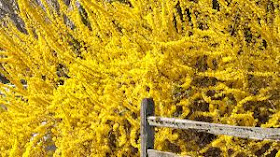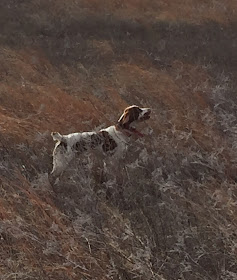 |
| Cap and Me in Mearns Country |
 |
| Walking the Mearns Valley |
The annual trip to Arizona coming, as it does, a few weeks prior to Christmas, is an exciting way to start the holidays, or end the Fall. I'm not sure which. (Listen to the Podcast:
https://anchor.fm/randy-schultz/episodes/Arizona-Mearns-Quail--Dec--2019-e9d1nh ) Either way, I really enjoy the rolling hills in the mountains of southern Arizona. Mearns habitat, in this part of the world, must contain at least two ingredients shown in the picture above- the oak trees and the grass. Mearns eat mainly tubers they dig up with an extended middle toe. They leave little holes in the ground, under the oaks, where the tubers grow. Fresh holes mean a covey's been feeding there.
 |
| Male and female Mearns up against one of the oaks. |
The ground varies between smooth volcanic cinder on the tops, to dirt in the valleys, to rocky jumbles on the hillsides. The rocky jumbles are the reason I don't like to hunt there in the rain, or when it's slick with snow. At my age, I don't don't want to fall and break a hip! (Just kidding! I really don't want to fall and break anything, at all!)
 |
| Shack, Moose, me |
This year, Wally (my friend who's hunted these birds for 35+ years) decided to initiate a young man, John, from Arkansas, into the Loyal Order of Mearns Hunters. John rented a house in Patagonia for two weeks, and brought his wife and two children with him. Now, that's optimism when looking for a niche bird! His dog, a Pudelpointer, Moose, was energetic, friendly, and had a great nose. For a day or two, Moose got a lot of backing practice until he discovered the scent we were looking for. Once he figured that out, he was on his way!
 |
| John looking down at Cap on Point 30 yards farther down! |
The first few days, we hunted in the same draws and canyon as the numerous hunters staying in campers, tents, etc. Our results were similar to theirs, as well. We logged 3 coveys the first day and 4 coveys the second day. Both days were cool in the morning and warm (70) in the afternoon. The dogs were fit, but running up those steep hills in the heat took a toll on them. It was tough.
 |
| John and Moose with his double! |
We moved to higher country to avoid the crowds at lower elevation. Luckily, the day dawned cool and damp, with rain forecast for later in the day. I went to my two best dogs, Cap and Shack, both no nonsense, experienced Brit males. I was only 5 minutes from the truck, on the side of a slope, when Cap locked up, Shack backing.
 |
| Cap hitting a covey of Mearns! |
The rest of the morning was spent easing along and waiting for the pager in my Garmin Alpha to alert me to one of the dogs on point. The perfect storm of my best dogs, cool wet weather, and plenty of birds gave us an outstanding morning! Along the way, John nailed, not only his first Mearns Quail, but a double! 7 coveys in 3 hours in this country is the best I've ever had. Even though I've tallied more coveys in a day, never in that short of period. At noon, we broke for lunch. Then, the rain came in earnest. This country is beautiful, but can be treacherous when wet. We curtailed our hunting for the day, my last day in the mountains this year.
 |
| John, me, Wally, Vince celebrating a great opening week. |
As luck would have it, a brewery opened in Sonoita, AZ, this year. It was a perfect place to stop and relive the last few days. We also discussed the near accident I was in while driving out on the narrow 1.5 lane road. The wet roads were narrow and curvy. As I crossed over a creek (as in through the creek), I came out the other side as the road narrowed even more. I eased as far right as I thought safe, just as the road bent to the left in a stand of trees. Suddenly, a pickup truck came around the corner, and I thought he looked a little close. We touched mirrors with a smash that left my mirror dangling from the power cord. I couldn't stop in this section of road, so I looked for some widening before I pulled off. By the time I did, John, behind me in his own truck, told me it looked like a bomb went off with all the plastic and glass in the air. We laughed about it, since the other truck kept moving, and some Border Patrol trucks zoomed by in pursuit. I was just happy the damage was confined to my mirror, and we remounted to continue home. A mile later, blue lights went off in my mirror- lots of blue lights! I pulled over, yet again, and got out to confront the driver of the other truck that hit me- an undercover Border Patrol agent! His mirror looked worse than mine. He was very apologetic, and explained they were chasing some drug smugglers, but he would stay and fill out the papers, etc. I told him, "No way! Go get those jerks, I'll handle this. It's just a mirror. I appreciate you guys!" He and two more marked trucks took off back down the road. I told my wife it was our contribution to our country's security. We lifted a glass to birds, bird hunters, and the USA!
I moved over to New Mexico for another 7 days of hunting Blue Quail. We had a blast, as my friend Bobby has a 4 seat Polaris, and we drove that all over the oil fields and ranches (with permission). 12-15 coveys per day was the normal haul.
 |
| Good Blue Quail Cover |
I hasten to add, sighting a covey of Blue Quail in no way guarantees an actual shot at Blue Quail! They are affectionately known as, Running SOB's, and they would many times be long gone by the time the dogs got in the area. On a good note, this is a great year for sand spurs, or the lack thereof. I didn't need to boot my dogs once in the week we hunted there. That's the first time it's ever happened for me. Normally, booting dogs is just a normal chore out here.
 |
| Pearl and her Blue Quail |
From the mountains in Arizona, to the sandy hills of New Mexico, my annual trip to the Southwest is always one of my favorites. It always ends too soon. This year, as I turned the Beast East, with my cheap replacement mirror attached with Gorilla tape, I re-lived in my head the great times I had chasing two species of quail most hunters never see. And, I thanked Jesus for bird dogs and the little buzz bombs we love to hunt.
 |
| A tired Blue and an old man at the end of the hunt. |














































